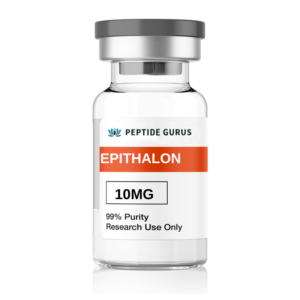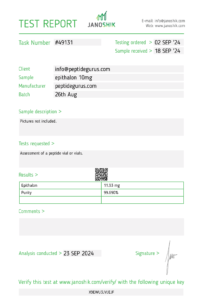1. Introduction
In the realm of anti – aging research and cellular rejuvenation, the
Epithalon peptide has emerged as a subject of great interest. This article will explore the relationship between Epithalon peptide and telomerase activation, its potential benefits, and how it aligns with current scientific knowledge and FDA guidelines.
2. Understanding Epithalon Peptide
2.1 Chemical Structure and Properties
Epithalon, also known as Epithalamin, is a synthetic tetrapeptide. Its chemical structure consists of four amino acids: alanine – glutamic acid – aspartic acid – glycine (Ala – Glu – Asp – Gly). The peptide is synthesized to high – purity standards, often with a purity level of over 98%. As a white to off – white lyophilized powder, it is stable under proper storage conditions. Recommended storage is at -20°C to maintain its integrity and biological activity over an extended period.
2.2 Source and Development
Epithalon was initially discovered in the pineal gland of animals. Researchers hypothesized that substances from the pineal gland could have regulatory effects on the body’s biological rhythms and cellular processes. Through synthetic methods, Epithalon was created to study its potential applications further. The development of Epithalon aimed to understand and potentially manipulate cellular aging processes at a molecular level.
3. Telomeres and Telomerase: A Brief Overview
3.1 Telomeres
Telomeres are repetitive DNA sequences located at the ends of chromosomes. They act like protective caps on the chromosomes, similar to the plastic tips on shoelaces. Each time a cell divides, the telomeres shorten. When telomeres become too short, the cell can no longer divide properly, and it may enter a state of senescence or die. This shortening of telomeres is associated with the aging of cells and, ultimately, the aging of the organism.
3.2 Telomerase
Telomerase is an enzyme that has the unique ability to lengthen telomeres. It adds repetitive DNA sequences to the ends of telomeres, counteracting the shortening that occurs during cell division. In normal somatic cells, telomerase activity is very low or absent. However, in some cells like stem cells and cancer cells, telomerase is active, allowing these cells to divide continuously.
4. Epithalon Peptide and Telomerase Activation
4.1 Research Findings
Research has suggested that Epithalon may play a role in activating telomerase. In in – vitro studies using cell cultures, the addition of Epithalon has been associated with an increase in telomerase activity. This activation could potentially lead to the lengthening of telomeres, which may slow down the aging process of cells.
In animal studies, administration of Epithalon has shown promising results. For example, in some studies on laboratory mice, Epithalon treatment was associated with an increase in telomerase activity in certain tissues. This led to an improvement in the overall health of the animals, including better immune function and increased lifespan in some cases.
4.2 Potential Mechanisms
The exact mechanism by which Epithalon activates telomerase is still under investigation. One hypothesis is that Epithalon may interact with specific receptors on the cell surface, triggering a signaling cascade that ultimately leads to the activation of the genes responsible for producing telomerase. Another possibility is that Epithalon directly affects the telomerase enzyme itself, either by modifying its structure or by enhancing its catalytic activity.
5. Potential Benefits of Epithalon – Mediated Telomerase Activation
5.1 Anti – Aging Effects
If Epithalon can effectively activate telomerase and lengthen telomeres, it could have significant anti – aging effects. By slowing down the aging process of cells, it may help maintain the integrity and function of tissues and organs in the body. This could potentially lead to a reduction in age – related diseases such as cardiovascular disease, neurodegenerative diseases, and some types of cancer.
5.2 Improved Immune Function
Aging is often associated with a decline in immune function, a phenomenon known as immunosenescence. Since Epithalon has been shown to increase telomerase activity in immune cells in some studies, it may help rejuvenate the immune system. This could result in a better ability to fight off infections, reduce the risk of autoimmune diseases, and improve overall immune – related health.
5.3 Tissue Repair and Regeneration
Telomere length and telomerase activity are also important for tissue repair and regeneration. Cells with longer telomeres and active telomerase are more likely to divide and replace damaged or dead cells. Epithalon – mediated telomerase activation may enhance this process, leading to faster wound healing, better recovery from injuries, and potentially improved treatment outcomes for conditions that involve tissue damage.
6. FDA Guidelines and Epithalon
As of July 2024, the FDA has not approved Epithalon for any medical use. The FDA has strict guidelines for the approval of drugs and biologics. For a substance like Epithalon to be considered for approval, it must undergo extensive pre – clinical and clinical studies.
Pre – clinical studies involve testing on cell cultures and animal models to evaluate safety and efficacy. These studies need to determine the appropriate dosage, potential side effects, and the optimal route of administration. Clinical trials in humans then follow a three – phase process. Phase 1 trials focus on testing the safety of the substance in a small group of healthy volunteers. Phase 2 trials expand the study to a larger group of patients with the target condition to evaluate efficacy and further assess safety. Phase 3 trials are large – scale, multi – center studies to confirm the effectiveness and safety of the treatment.
Manufacturers must also adhere to Good Manufacturing Practice (GMP) guidelines to ensure the quality and consistency of the product. Since Epithalon is not currently approved, any claims regarding its use for medical purposes, such as anti – aging or treatment of specific diseases, should be viewed with caution.
7. Common Questions and Answers
7.1 Question 1: Can I take Epithalon to reverse the aging process?
Answer: While Epithalon shows potential in research for its role in telomerase activation and anti – aging effects, it has not been approved by the FDA for this purpose. There is not enough evidence yet to conclude that it can safely and effectively reverse the aging process in humans. Self – administration of Epithalon is not recommended as its long – term safety and efficacy are still being studied.
7.2 Question 2: Are there any side effects of Epithalon?
Answer: Since Epithalon is not approved for human use, its full side – effect profile is not well – known. In pre – clinical studies, no major adverse effects have been reported so far. However, as with any substance, especially those that can affect cellular processes like telomerase activation, there could be potential side effects. These may include unknown long – term effects on cell growth and division, which could potentially lead to problems such as abnormal cell proliferation or cancer.
7.3 Question 3: When will Epithalon be available as a treatment?
Answer: It’s difficult to predict when or if Epithalon will be available as a treatment. It first needs to complete extensive pre – clinical and clinical trials and meet FDA approval requirements. Given the complexity of these processes, it could take several years or even decades before it becomes available, assuming it passes all the necessary tests for safety and efficacy.

